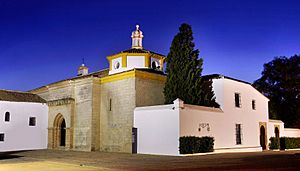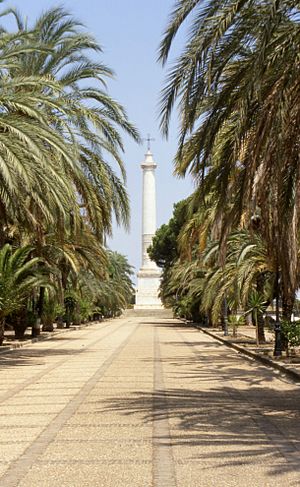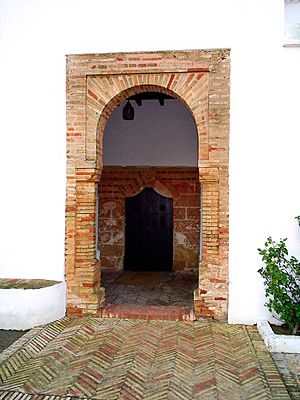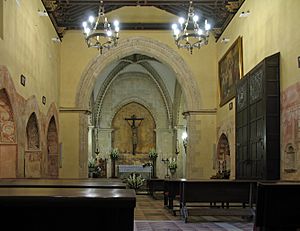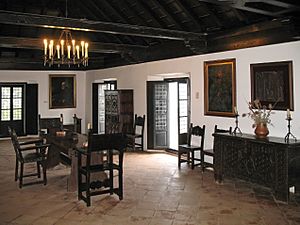La Rábida Friary facts for kids
The Friary of La Rábida (its full name is Convento de Santa María de la Rábida) is a historic Franciscan monastery in southern Spain. It's located in Palos de la Frontera, a town in the province of Huelva, Andalucia. You can find it where the Tinto and Odiel rivers meet, about 13 kilometers (8 miles) south of Huelva.
This friary has been a home for Franciscan friars since the 1200s. It was founded in 1261. The first Christian building here was built over an old Almohad "ribat." A ribat was like a watchtower, and that's where the name "Rábida" comes from! The Franciscans have been very important in this area ever since.
The buildings you see today were built in the late 1300s and early 1400s. The friary and its church show styles from Gothic and Moorish revival architecture. Their walls have beautiful paintings by the Spanish artist, Daniel Vázquez Diaz. There's also a peaceful cloister and a museum. The museum displays many items connected to the discovery of the Americas.
The friary buildings cover nearly 20,000 square feet (1,858 square meters). Over its 500 years, the monastery has been fixed many times. The biggest repairs happened after the huge Lisbon earthquake of 1755.
Christopher Columbus stayed at the friary two years before his famous first voyage. He had just learned that King Ferdinand and Queen Isabella had said no to his plan. He wanted them to pay for an expedition to find the Indies. But with help from the friary's guardian and Queen Isabella's confessor, he got another chance to present his idea.
The friary was named a Spanish National Monument in 1856.
Contents
History of La Rábida
The friary sits on a rocky hill overlooking the Tinto and Odiel rivers. This spot has been important for a long time. In ancient times, the Phoenicians built an altar here for their god, Melqart. Later, the Romans used this same place to worship the goddess, Proserpina.
The Arabs built a "ribat" here. This was a small monastery where monk-warriors trained. The word rábida comes from an Arabic word meaning "watchtower." You can still see ruins of similar Moorish towers along the Costa de la Luz. Muslim holy men used these places to become stronger in spirit. This helped them defend this part of the Moorish empire in Iberia.

In the 1100s, the site was looked after by the Knights Templar. In the 1200s, it became a Franciscan friary. Some stories say that St. Francis of Assisi himself visited here. He supposedly came with twelve followers to start a small community. Like the Moors and Templars before them, the Franciscans made this a strong place. It helped them resist attacks from pirates along the coast.
Pope Eugene IV even offered special blessings to anyone who helped travelers seeking safety here. Many of the buildings for the Conventual Franciscans were built in the early 1400s. Important people like Don Juan Alfonso de Guzman El Bueno, the first Duke of Medina Sidonia, helped with the building. Local people also worked together on the projects.
The friary is most famous because Christopher Columbus visited in 1490. He talked with the Franciscans, like Horacio Crassocius, about his plans for a voyage of discovery. Columbus later decided to take Crassocius with him as a servant.
After a time when many church properties were taken by the government, the friary fell into ruins. But in 1855, people started to restore it. Prince Antoine, Duke of Montpensier and local leaders helped with this. In 1882, King Alfonso XII visited. He supported more work to get the friary ready for the 400th anniversary of the discovery of the Americas in 1892. The king hired architect Ricardo Velázquez Bosco. His work respected the original feel of the building.
The Buildings of the Friary
The Church
We don't know exactly when the church was built. One old part that is still well-preserved is the main doorway, which looks like an arch. Other features include paintings on the walls and a carefully painted ceiling with a Moorish style. On the walls, there is also an 18th-century painting of St. John of God. You can also see pictures showing the life of St. Francis of Assisi.
At the main altar, there is a sculpture of Christ. This replaced an older statue that was destroyed during the Spanish Civil War. In the south wall, there's a small chapel. It is dedicated to the friary's patron, Our Lady of Miracles. There is a 14th-century alabaster carving of her in the church.
The Cloister
The cloister is built in the Moorish revival style and dates from the 1400s. It is still in good condition. In the 1600s, it was made bigger with a second floor. This floor had battlements to help defend against pirate attacks. Today, it has modern paintings, and some pieces of the original paintings are still there. On the second floor, you can see models of the three caravels from Columbus's first voyage: the Niña, the Pinta, and the Santa Maria.
Other Important Rooms
The refectory is a long room with rows of tables. It has a whitewashed pulpit where readings or lectures would take place during meals.
The library holds old documents and interesting objects. The most famous is the map of the world by Juan de la Cosa. This map was the first to show the coast of the Americas.
There is also an exhibition room. Here you can see flags from countries in the Americas. There is also a small sealed container with soil from the New World.
Around a small courtyard filled with plants and flowers are rooms decorated with colorful paintings. These were done by the Spanish painter, Daniel Vázquez Diaz, in 1930. The paintings show scenes of Columbus and his journey. They are in a style that came before cubism, which Vázquez Diaz had learned in Paris.
The Area Around the Monastery
In the garden, you'll find The Column of the Discoverers. This monument celebrates the 400th anniversary of Columbus's first voyage. It is made of bright white stone. It has many figures and scenes showing the colonization of the Americas.
In front of the main entrance, there is an iron cross. You can also see busts (head and shoulders sculptures) of the Franciscan friars, Juan Pérez and Antonio de Marchena. Both were made by the sculptor León Ortega.
Next to the entrance, there is a plaque made of azulejos (painted tiles). It says: "The Rábida is the first sign of the Hispano-American movement. This place, where the idea of a New World was born, is special to people everywhere. Any Spaniard or American who thinks deeply must ask, 'Won't you help us spread love and peace, the feelings that come from this humble monastery?' Christ, whom Columbus, Friar Juan Perez, Friar Marchena, and the Pinzóns all prayed to, welcomes people of all beliefs who have good intentions."
Our Lady of Miracles
St. Mary, the mother of Jesus, is the special patroness of the friary. A small statue of her is in the friary church. This statue is carved from alabaster. Its style is from the 14th-century Andalucian art school.
According to an old story, a sailor from Palos de la Frontera brought this statue back from a trip. Because the Moors were still in Spain, it was hidden by putting it underwater off the Huelva coast. Later, fishermen found it in their nets and returned it to the monastery church. One thing is certain: Columbus and some of his crew prayed before this statue just hours before sailing for the New World.
See also
 In Spanish: Monasterio de La Rábida para niños
In Spanish: Monasterio de La Rábida para niños
Note
This article is based on a translation of the corresponding article from the Spanish Wikipedia.


